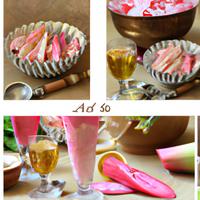
1 serving (100 grams) contains 200 calories, 3.0 grams of protein, 10.0 grams of fat, and 25.0 grams of carbohydrates.

Log this food in SnapCalorie

Nutrition Information
Calories |
476.2 | ||
|---|---|---|---|
% Daily Value* |
|||
| Total Fat | 23.8 g | 30% | |
| Saturated Fat | 14.3 g | 71% | |
| Polyunsaturated Fat | 0 g | ||
| Cholesterol | 71.4 mg | 23% | |
| Sodium | 119.0 mg | 5% | |
| Total Carbohydrates | 59.5 g | 21% | |
| Dietary Fiber | 2.4 g | 8% | |
| Sugars | 47.6 g | ||
| protein | 7.1 g | 14% | |
| Vitamin D | 0 mcg | 0% | |
| Calcium | 190.5 mg | 14% | |
| Iron | 0.5 mg | 2% | |
| Potassium | 357.1 mg | 7% | |
* Percent Daily Values are based on a 2,000 calorie diet. Your daily values may be higher or lower depending on your calorie needs.
Food Attributes
Source of Calories
About Rhubarb ice cream
Rhubarb ice cream is a delightful dessert that combines the tangy, slightly tart flavor of rhubarb with the creamy richness of ice cream. Typically made with fresh rhubarb, sugar, cream, milk, and sometimes eggs, this frozen treat balances sweetness with the unique zing of rhubarb, a classic ingredient in European and North American cuisines. Rhubarb itself is a low-calorie vegetable packed with antioxidants, vitamins K and C, and fiber. However, rhubarb ice cream's nutritional profile is influenced by added sugars and fats, making it more indulgent than health-focused. While it's not a dietary staple, enjoying rhubarb ice cream in moderation can provide a refreshing way to experience the distinct taste of rhubarb while satisfying dessert cravings. Perfect for spring and summer months, it stands out as a seasonal favorite for many passionate home cooks and ice cream lovers.



